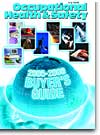
July 2005
Features
By Heather Koehn
AN alarm sounds. An emergency fixture is activated, and a rusty fluid begins gurgling through the pipes. An injured worker uses the emergency unit, not suspecting the water used to flush his body and eyes has been collecting sediment for months or even years. Only later is it learned that the contaminated fluid severely worsened the worker's condition and caused long-term health damage.
By Edwin Zalewski
MATERIALS handling often focuses on storage and transport by equipment, including forklifts. However, employee behaviors and work practices, such as using poor lifting techniques, also contribute to many injuries.
By Jerry Laws
Editor's note: "White powder" incidents continue to occur in the United States, largely at mailrooms. U.S. Postmaster General John E. Potter asked Congress in April for $51 million for security costs associated with a Biohazard Defense System, a Ventilation and Filtration System, and a mail sanitization facility to be located in Washington, D.C.
By Jerry Laws
Editor's note: The ranks of safety and health consultants have exploded in recent years. Patricia Carlisle, CIH, who has been certified in the comprehensive practice of industrial hygiene by the American Board of Industrial Hygiene since 1990 and has been a private consultant for about 20 years, discussed competition, networking, and other consulting challenges in an April 21, 2005, conversation with Occupational Health & Safety's editor.
By Craig Halls
HOW many employers or employees were faced with the following scenarios in the last five years: a change in health plan vendors, a decrease in benefits coverage, or increased cost sharing for the insurance premium?
By Jess Kraus
HOW are you managing the hazardous materials you use, store, and produce in your facility? Unless you have a multimillion-dollar budget and work in an organization with a cultural commitment to safety and risk management, you are probably managing ever-more-complex rules and requirements with smaller budgets, fewer resources, and less organizational commitment than the year before.
By John O'Brien
YOU wouldn't think Ed Smolinski has much in common with Sherlock Holmes. But upon closer examination, you would realize the president of Allied Environmental Corp. does bear a similarity to the famous fictional sleuth.
By Jerry Laws
Editor's note: Safety directors should be aware of who's buying protective footwear, what types the workers are buying, and how much they are spending. Workers, for their part, must buy footwear suited to their hazard exposure and must watch for damage and obtain replacements when necessary, advise Mark Fancourt, who works in product development for Lehigh Safety Shoe Company (www.ejfootwear.com) of Vestal, N.Y., and Paul Russo, Executive Vice President of Global Sourcing and Marketing for Iron Age Corp. (www.IronAgeShoes.com) of Westborough, Mass. Fancourt and Russo discussed best practices for employer purchase programs and other issues on May 26 and May 31, 2005, respectively, with Occupational Health & Safety's editor. Excerpts from those conversations follow:
By Jim Barnes
THE mission of the Occupational Safety and Health Administration is to assure the safety and health of America's workers by setting and enforcing standards; providing training, outreach, and education; establishing partnerships; and encouraging continual improvement in workplace safety and health.
By Karen D. Hamel
FORTUNATELY, it's not every day that a 10,000-gallon holding tank fails or a forklift harpoons a drum of solvent sitting next to a floor drain. But no matter what spills, facilities need to be prepared.
By Michael Banahan, Robert Hinson
A driver for a messenger service is injured in a company car in a traffic accident on his way to work.
By Harry L. Smith
IF you have more work than time, then the answer to the question above should be yes. Today, almost all administrative, management, planning, and tracking functions of safety can be tackled with readily available and, usually, reasonably priced off-the-shelf software.
By Stephen V. Magyar, Jr., MBA, CSP
THE safe operation of a forklift is a skill that requires the ability to anticipate accidents. When this ability is learned through "trial and error," it is only evaluated when property damage or serious injury occurs.
By Kim Meyer
WORKING with electrical systems exposes utility workers to an average of five to ten explosions of energy every day. When working with these same electrical systems at height, there is no room for error.
By Jeff Goodwin
IMAGINE this: An employee walks into a hazardous workplace environment and sustains a foot injury that could have been prevented. While the employee must now endure a painful injury and lost time from work, his employer is faced with a dip in productivity and exposure to a potentially damaging worker's compensation claim.
Departments
By Emily Bryant
IT'S an ordinary day at the hospital where you work as a nurse. You've seen fairly run-of-the mill cases: colds, a minor bronchial infection, and two people with the flu. A patient checks in with a fever, body aches, nausea, and chills, as well as a rash consisting of dense, firm lesions.
By Francie Dalton
IMPLEMENTING a 360-degree review process will either be a destructive and devastating experience or a developmental epiphany for those involved, depending entirely on how the process is structured. This article focuses on the seven reasons why 360s fail and provides best practice solutions for each.